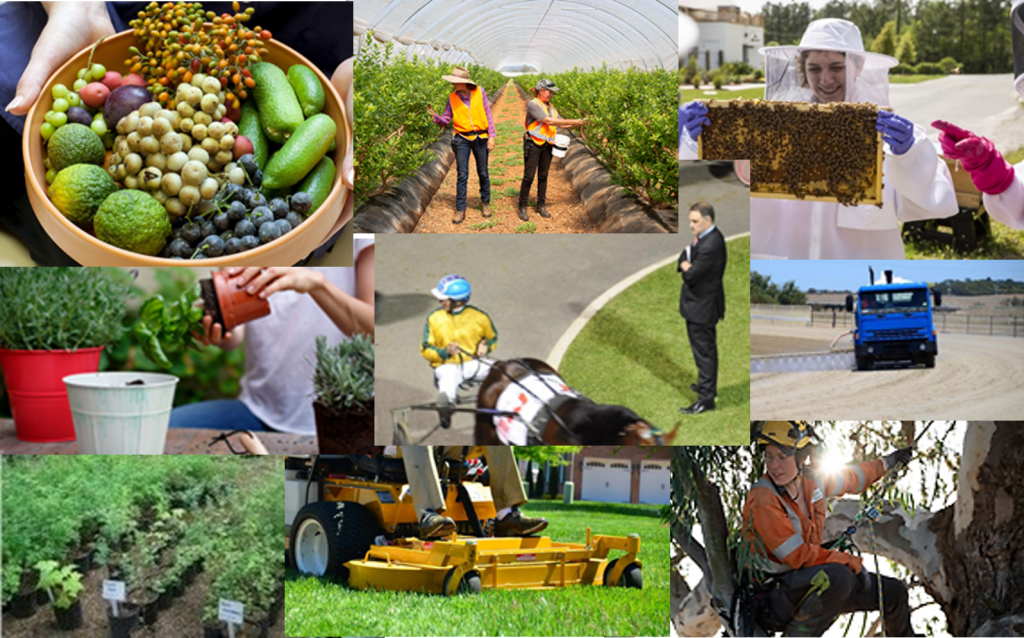
A series of helpful resources have been developed to help provide information and guidance for key occupations and careers in the MAE targeted agrifood industries. These include Job Guides, Career Resources, Career Flow Charts and other supporting materials which are listed below and can be downloaded by clicking on the specific resource.
1. Agriculture:
The agriculture industry (targeted by this MAE project) includes but is not limited to beekeeping, pollination servicing, production horticulture and irrigation.
– Beekeeping industry :
The Australian beekeeping industry sector consists of approximately 30,000 registered beekeepers who own a total of around 668,000 hives. Australia is one of the top ten honey producing countries in the world, with a large amount of honey produced in Australia exported to a variety of countries overseas in both bulk and retail shipments. 65 % of the food we eat in Australia benefits from honeybee pollination. Commercial beekeeping ( which includes both honey production and pollination services) has been incredibly successful because of the extensive areas of native vegetation available in Australia.
The use of bees for pollination services plays a significant role in the success of many agricultural industries. Commercial pollination of crops and orchards is being recognised as a growth industry in Australia.
– Production horticulture industry:
The Production horticulture industry sector is Australia’s second largest rural producer with most of the products being grown for fresh or processing outlets within Australia. Horticultural exports make up approximately 13% of total value of production. Fruits dominate horticultural exports with oranges, table grapes and apples being in high demand.
2. Amenity Horticulture :
The amenity horticulture includes but is not limited to production and retail nursery, landscape construction, landscape design, and arboriculture.
– Nursery and Garden industry :
The nursery industry sector operates in all states and territories of Australia, being one of the largest and most diverse plant industries in the country; it is also listed as part of the amenity horticulture industry.
– Landscape Contracting industry:
The landscape construction industry sector is unique. Landscape construction or sometimes called structural landscaping is one of the many branches of amenity horticulture. Structural landscaping is work involved in the construction of external landscape features, and non-habitable structures (structures you cannot live in). So, when you see a landscape project such as a garden area with a deck, pergola, gazebo, privacy screen, or entertainment area, all of these features are constructed by people with structural landscaping training.
– Arboriculture industry :
According to Arboriculture Australia, the industry sector employs over 40,000 workers with a turnover of over one billion dollars annually. However, there is an increased shortage of skilled workers to take up roles across the industry. Many arborist roles require aerial access work and operations of chainsaws – so it is vital the workforce is equipped with technical skills and sector specific safety standards. Arboriculture is vital to the welfare of trees, the ongoing protection of trees and their impact on the environment.
3. Racing industry:
The racing industry in Australia incorporates a diverse range of businesses including horse racing (thoroughbred and harness), greyhound and horse breeding. It also includes the management of the facilities used specifically for those activities. Almost all occupations in racing require relevant industry licences, which are coordinated through the industry’s peak bodies.
The racing industry is an exciting and vibrant industry that contributes approximately $1.4 billion to the Australian gross domestic product and employs thousands of people either directly or in related service industries.
4. Food, science and technology industry:
The food, science and technology industries includes but is not limited to food processing, laboratory operations and quality assurance.
The industry is an exciting and vibrant industry that contributes approximately $1.4 billion to the Australian gross domestic product and employs thousands of people either directly or in related service industries.
– Laboratory Operations:
Laboratory Operations is not an industry sector as such. It refers to a diverse group of certain technical and scientific occupations such as Samplers, Testers and Laboratory Personnel that appear across industries.
Most jobs are within the Automotive, Food and Pharmaceutical Production or Manufacturing industries. Laboratory Services play a critical role in the safety, quality and compliance of many industry sectors and for this reason, the sector is highly regulated.
– Quality Assurance:
The Australian food processing sector of the manufacturing and process industry is diverse and internationally recognised for producing high-quality processed foods. An array of other manufacturing and processes industry sectors too, rely extensively on quality assuring the manufacture and production of products and goods to meet specifications and standards. This makes quality assurance an important function within an organisation.
AGRIFOOD RESOURCES
1. JOB GUIDES
- Arborist Job Guide
- Beekeeping Job Guide
- Horticultural Nursery Person Job Guide
- Irrigation Technician Job Guide
- Laboratory Technician Job Guide
- Landscaper Job Guide
- Production Horticulture Worker Job Guide
- Racing Steward Job Guide
- Track Maintenance Job Guide
- Quality Assurance Officer Job Guide
2. CAREER RESOURCES
- Arborist Career Resource
- Beekeeping Career Resource
- Horticultural Nursery Person Career Resource
- Irrigation Technician Career Resource
- Laboratory Technician Career Resource
- Landscaper Career Resource
- Production Horticulture Worker Career Resource
- Racing Steward Career Resource
- Track Maintenance Career Resource
- Quality Assurance Officer Career Resource
3. CAREER FLOW CHARTS
- Laboratory Technician Career Flow Chart
- Landscaper Flow Chart
- Production Horticulture Worker Flow Chart
- Racing Steward Flow Chart
- Quality Assurance Career flowchart
GENERAL RESOURCES:
Media
TBA
Promotional materials
TBA
Resource and website visitor feedback survey
The resources have been developed in consultation with industry and the website has be assembled in line with the project objectives and resources arrangement. To maintain both current, error free and relevant we invite you to review them and provide feedback at your convenience via the following links:
Return to MAE Career Resource Centre – CLICK HERE
